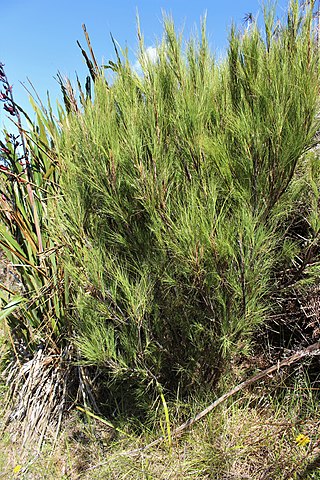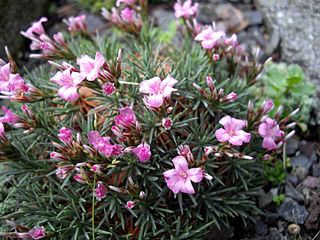
Plumbaginaceae is a family of flowering plants, with a cosmopolitan distribution. The family is sometimes referred to as the leadwort family or the plumbago family.

Acantholimon is a genus of small flowering plants within the plumbago or leadwort family, Plumbaginaceae. They are distributed from southeastern Europe to central Asia, and also cultivated elsewhere in rock gardens.
Xenophyllum acerosum is a species of flowering plant in the family Asteraceae. It is found only in Ecuador. Its natural habitat is subtropical or tropical dry shrubland. It is threatened by habitat loss.
Acantholimon koeycegizicum, is a species of plant belonging to the family Plumbaginaceae.

Conospermum acerosum, commonly known as needle-leaved smokebush, is a species of flowering plant in family Proteaceae and is endemic to the south west of Western Australia. It is spindly, erect or straggly shrub with needle-shaped or thread-like leaves, panicles of white or pink flowers and reddish brown nuts.

Acantholimon libanoticum(Lebanese prickly thrift, غملول لبناني) is a plant in the family Plumbaginaceae first described by Pierre Edmond Boissier. It is native to Western Asia from Turkey to Syria and Lebanon.
Acantholimon gillii is a species of plant described by Karl Heinz Rechinger and Mogens Engell Köie. Acantholimon gillii is part of the genus Acantholimon and the family Plumbaginaceae. No subspecies are listed in the Catalog of Life.

Dracophyllum acerosum is a species of shrub or small tree endemic to New Zealand's South Island. It was first described by Sven Berggren in 1877 and gets the specific epithet acerosum, meaning needles shaped, for its leaves. In the heath family Ericaceae, it inhabits mountain slopes, ridge lines and hillsides and reaches a height of 1–2 m (3–7 ft). A 2017 assessment using the New Zealand Threat Classification System classified it as "Not Threatened", giving it an estimated population of more than 100,000.
Acantholimon ekatherinae is a species of Plumbaginaceae in the genus Acantholimon. It native to Kazakhstan and Uzbekistan in central Asia.
Acantholimon acanthobryum is a species of flowering plant in the Plumbaginaceae family. The species is epidemic to Ghazni, Afghanistan and was discovered by Rech.f. & Schiman-Czeika.

Acantholimon ulicinum, also known as the prickly thief, is a species of broadleaf evergreen plants in the family Plumbaginaceae. Acantholimon ulicinum is around 10 cm (4 in) tall and has a spread of 30 cm (1 ft). The species is endemic to the eastern Mediterranean region where it grows in dry soil. From June to July is when Acantholimon ulicinum blooms, with pale pink flowers. It has crowded, rigid, hard-textured, spiny-tipped, linear and needle-like leaves, and five-petaled pink flowers in short-stalked inflorescences.
Acantholimon afanassievii is a species of flowering plant in the Plumbaginaceae family. The native range of this species is in Central Asia and it was discovered by Lincz.
Acantholimon tataricum is a species of flowering plant in the family Plumbaginaceae. The native range of this species is in Xinjiang and the Western Himalayas and it was discovered by Boiss.
Acantholimon collare is a species of flowering plant in the Plumbaginaceae family described by Mogens Engell Köie and Karl Heinz Rechinger. The native range of this species is North East Iran. A phytochemical analysis from the University of Birjand found that the antimicrobial nature of compounds found in A. collare make it potentially suitable for pharmaceutical use.
Acantholimon schemachense is a species of flowering plant in the Plumbaginaceae family. The native range of this species is in the North Caucasus and the Transcaucasus, and it was described by Gross in 1931.
Acantholimon riyatguelii is a species of flowering plant in the family Plumbaginaceae. The native range of this species is in Turkey and Iran. It was first described by Hasan Yıldırım in 2014.
Acantholimon ahangarense is a species of flowering plant in the family Plumbaginaceae. The native range of this species is Afghanistan (Ghorat) and was described by Rech.f. & Schiman-Czeika.
Acantholimon alaicum is a species of flowering plant in the family Plumbaginaceae. The native range of this species is Central Asia, more specifically Kyrgyzstan and was described by Czerniak.
Acantholimon alavae is a species of flowering plant in the family Plumbaginaceae. The native range of this species is Iran and was described by Rech.f. & Schiman-Czeika.






